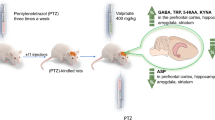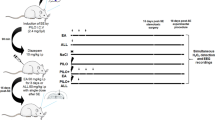Abstract
Although purinergic receptor activity has lately been associated with epilepsy, little is known about the exact role of purines in epileptogenesis. We have used a rat model of temporal lobe epilepsy induced by pilocarpine to study the dynamics of purine metabolism in the hippocampus during different times of status epilepticus (SE) and the chronic phase. Concentrations of adenosine 5′-triphosphate (ATP), adenosine diphosphate (ADP), adenosine monophosphate (AMP), and adenosine in normal and epileptic rat hippocampus were determined by microdialysis in combination with high-performance liquid chromatography (HPLC). Extracellular ATP concentrations did not vary along 4 h of SE onset. However, AMP concentration was elevated during the second hour, whereas ADP and adenosine concentrations augmented during the third and fourth hour following SE. During chronic phase, extracellular ATP, ADP, AMP, and adenosine concentrations decreased, although these levels again increased significantly during spontaneous seizures. These results suggest that the increased turnover of ATP during the acute period is a compensatory mechanism able to reduce the excitatory role of ATP. Increased adenosine levels following 4 h of SE may contribute to block seizures. On the other hand, the reduction of purine levels in the hippocampus of chronic epileptic rats may result from metabolic changes and be part of the mechanisms involved in the onset of spontaneous seizures. This work provides further insights into purinergic signaling during establishment and chronic phase of epilepsy.



Similar content being viewed by others
References
Engel J Jr (2001) Intractable epilepsy: definition and neurobiology. Epilepsia 42(Suppl 6):3
Devinsky O (2004) Diagnosis and treatment of temporal lobe epilepsy. Rev Neurol Dis 1(1):2–9
Detour J, Schroeder H, Desor D, Nehlig A (2005) A 5-month period of epilepsy impairs spatial memory, decreases anxiety, but spares object recognition in the lithium-pilocarpine model in adult rats. Epilepsia 46(4):499–508. doi:10.1111/j.0013-9580.2005.38704.x
Sloviter RS (2005) The neurobiology of temporal lobe epilepsy: too much information, not enough knowledge. C R Biol 328(2):143–153
Turski WA, Czuczwar SJ, Kleinrok Z, Turski L (1983) Cholinomimetics produce seizures and brain damage in rats. Experientia 39(12):1408–1411
Cavalheiro EA (1995) The pilocarpine model of epilepsy. Ital J Neurol Sci 16(1-2):33–37
Delorenzo RJ, Sun DA, Deshpande LS (2005) Cellular mechanisms underlying acquired epilepsy: the calcium hypothesis of the induction and maintainance of epilepsy. Pharmacol Ther 105(3):229–266. doi:10.1016/j.pharmthera.2004.10.004
Raza M, Blair RE, Sombati S, Carter DS, Deshpande LS, DeLorenzo RJ (2004) Evidence that injury-induced changes in hippocampal neuronal calcium dynamics during epileptogenesis cause acquired epilepsy. Proc Natl Acad Sci U S A 101(50):17522–17527. doi:10.1073/pnas.0408155101
Vianna EP, Ferreira AT, Naffah-Mazzacoratti MG, Sanabria ER, Funke M, Cavalheiro EA, Fernandes MJ (2002) Evidence that ATP participates in the pathophysiology of pilocarpine-induced temporal lobe epilepsy: fluorimetric, immunohistochemical, and Western blot studies. Epilepsia 43(Suppl 5):227–229
Dona F, Ulrich H, Persike DS, Conceicao IM, Blini JP, Cavalheiro EA, Fernandes MJ (2009) Alteration of purinergic P2X4 and P2X7 receptor expression in rats with temporal-lobe epilepsy induced by pilocarpine. Epilepsy Res 83(2-3):157–167. doi:10.1016/j.eplepsyres.2008.10.008
Burnstock G, Krugel U, Abbracchio MP, Illes P (2011) Purinergic signalling: from normal behaviour to pathological brain function. Prog Neurobiol 95(2):229–274. doi:10.1016/j.pneurobio.2011.08.006
Abbracchio MP, Burnstock G, Verkhratsky A, Zimmermann H (2009) Purinergic signalling in the nervous system: an overview. Trends Neurosci 32(1):19–29. doi:10.1016/j.tins.2008.10.001
Bruno AN, Oses JP, Amaral O, Coitinho A, Bonan CD, Battastini AM, Sarkis JJ (2003) Changes in nucleotide hydrolysis in rat blood serum induced by pentylenetetrazol-kindling. Brain Res Mol Brain Res 114(2):140–145
Majumder P, Trujillo CA, Lopes CG, Resende RR, Gomes KN, Yuahasi KK, Britto LR, Ulrich H (2007) New insights into purinergic receptor signaling in neuronal differentiation, neuroprotection, and brain disorders. Purinergic Signal 3(4):317–331. doi:10.1007/s11302-007-9074-y
Ballarin M, Fredholm BB, Ambrosio S, Mahy N (1991) Extracellular levels of adenosine and its metabolites in the striatum of awake rats: inhibition of uptake and metabolism. Acta Physiol Scand 142(1):97–103. doi:10.1111/j.1748-1716.1991.tb09133.x
Levitt B, Head RJ, Westfall DP (1984) High-pressure liquid chromatographic-fluorometric detection of adenosine and adenine nucleotides: application to endogenous content and electrically induced release of adenyl purines in guinea pig vas deferens. Anal Biochem 137(1):93–100
Racine RJ (1972) Modification of seizure activity by electrical stimulation: II. Motor seizure. Electroencephalogr Clin Neurophysiol 32(3):281–294
Robson SC, Sévigny J, Zimmermann H (2006) The E-NTPDase family of ectonucleotidases: structure function relationships and pathophysiological significance. Purinergic Signal 2(2):409–430. doi:10.1007/s11302-006-9003-5
Braun N, Zhu Y, Krieglstein J, Culmsee C, Zimmermann H (1998) Upregulation of the enzyme chain hydrolyzing extracellular ATP after transient forebrain ischemia in the rat. J Neurosci 18(13):4891–4900
Chitolina Schetinger MR, Bonan CD, Schierholt RC, Webber A, Arteni N, Emanuelli T, Dias RD, Freitas Sarkis JJ, Netto CA (1998) Nucleotide hydrolysis in rats submitted to global cerebral ischemia: a possible link between preconditioning and adenosine production. J Stroke Cerebrovasc Dis 7(5):281–286
Vianna EP, Ferreira AT, Dona F, Cavalheiro EA, da Silva Fernandes MJ (2005) Modulation of seizures and synaptic plasticity by adenosinergic receptors in an experimental model of temporal lobe epilepsy induced by pilocarpine in rats. Epilepsia 46(Suppl 5):166–173. doi:10.1111/j.1528-1167.2005.01027.x
Bonan CD, Walz R, Pereira GS, Worm PV, Battastini AM, Cavalheiro EA, Izquierdo I, Sarkis JJ (2000) Changes in synaptosomal ectonucleotidase activities in two rat models of temporal lobe epilepsy. Epilepsy Res 39(3):229–238
Berman RF, Fredholm BB, Aden U, O’Connor WT (2000) Evidence for increased dorsal hippocampal adenosine release and metabolism during pharmacologically induced seizures in rats. Brain Res 872(1-2):44–53
Melani A, Turchi D, Vannucchi MG, Cipriani S, Gianfriddo M, Pedata F (2005) ATP extracellular concentrations are increased in the rat striatum during in vivo ischemia. Neurochem Int 47(6):442–448. doi:10.1016/j.neuint.2005.05.014
Smolders I, Khan GM, Manil J, Ebinger G, Michotte Y (1997) NMDA receptor-mediated pilocarpine-induced seizures: characterization in freely moving rats by microdialysis. Br J Pharmacol 121(6):1171–1179. doi:10.1038/sj.bjp.0701231
Engel T, Jimenez-Pacheco A, Miras-Portugal MT, Diaz-Hernandez M, Henshall DC (2012) P2X7 receptor in epilepsy; role in pathophysiology and potential targeting for seizure control. Int J Physiol Pathophysiol Pharmacol 4(4):174–187
Luthardt J, Borvendeg SJ, Sperlagh B, Poelchen W, Wirkner K, Illes P (2003) P2Y(1) receptor activation inhibits NMDA receptor-channels in layer V pyramidal neurons of the rat prefrontal and parietal cortex. Neurochem Int 42(2):161–172
Rodrigues RJ, Almeida T, Richardson PJ, Oliveira CR, Cunha RA (2005) Dual presynaptic control by ATP of glutamate release via facilitatory P2X1, P2X2/3, and P2X3 and inhibitory P2Y1, P2Y2, and/or P2Y4 receptors in the rat hippocampus. J Neurosci 25(27):6286–6295. doi:10.1523/jneurosci.0628-05.2005
Muzzi M, Coppi E, Pugliese AM, Chiarugi A (2013) Anticonvulsant effect of AMP by direct activation of adenosine A1 receptor. Exp Neurol 250:189–193. doi:10.1016/j.expneurol.2013.09.010
Honda S, Sasaki Y, Ohsawa K, Imai Y, Nakamura Y, Inoue K, Kohsaka S (2001) Extracellular ATP or ADP induce chemotaxis of cultured microglia through Gi/o-coupled P2Y receptors. J Neurosci 21(6):1975–1982
Fields RD, Burnstock G (2006) Purinergic signalling in neuron–glia interactions. Nat Rev Neurosci 7(6):423–436. doi:10.1038/nrn1928
Cavalheiro EA, Calderazzo Filho LS, Bortolotto ZA, Mello L, Turski L (1987) Anticonvulsant role of adenosine. Pol J Pharmacol Pharm 39(5):537–543
Dunwiddie TV, Fredholm BB (1989) Adenosine A1 receptors inhibit adenylate cyclase activity and neurotransmitter release and hyperpolarize pyramidal neurons in rat hippocampus. J Pharmacol Exp Ther 249(1):31–37
Dube C, Boyet S, Marescaux C, Nehlig A (2001) Relationship between neuronal loss and interictal glucose metabolism during the chronic phase of the lithium-pilocarpine model of epilepsy in the immature and adult rat. Exp Neurol 167(2):227–241. doi:10.1006/exnr.2000.7561
Theodore WH (1999) Cerebral blood flow and glucose metabolism in human epilepsy. Adv Neurol 79:873–881
Gouder N, Scheurer L, Fritschy JM, Boison D (2004) Overexpression of adenosine kinase in epileptic hippocampus contributes to epileptogenesis. J Neurosci 24(3):692–701. doi:10.1523/JNEUROSCI.4781-03.2004
Casse R, Rowe CC, Newton M, Berlangieri SU, Scott AM (2002) Positron emission tomography and epilepsy. Mol Imaging Biol 4(5):338–351
During MJ, Spencer DD (1992) Adenosine: a potential mediator of seizure arrest and postictal refractoriness. Ann Neurol 32(5):618–624. doi:10.1002/ana.410320504
Grosso S, Rocchi R, Margollicci M, Vatti G, Luddi A, Marchi F, Balestri P (2009) Postictal serum nucleotidases activities in patients with epilepsy. Epilepsy Res 84(1):15–20. doi:10.1016/j.eplepsyres.2008.11.020
Acknowledgments
This work was supported by the Brazilian funds from the Fundação de Amparo à Pesquisa do Estado de São Paulo (FAPESP, Nº. 2006/06502-4 and 2006/61285-9), Conselho Nacional de Desenvolvimento Científico e Tecnológico (CNPq), and Coordenação de Aperfeiçoamento de Pessoal de Ensino Superior (CAPES). We thank Hilda Silva Reis for technical assistance.
Author information
Authors and Affiliations
Corresponding author
Ethics declarations
Animal protocols were conducted in accordance with national and international legislation (Guidelines of the Brazilian College of Animal Experimentation, COBEA; NIH Guide for Care and Use of Laboratory Animals) and with the approval of the Ethical Committee of the University (Protocol. 0636/04).
Rights and permissions
About this article
Cite this article
Doná, F., Conceição, I.M., Ulrich, H. et al. Variations of ATP and its metabolites in the hippocampus of rats subjected to pilocarpine-induced temporal lobe epilepsy. Purinergic Signalling 12, 295–302 (2016). https://doi.org/10.1007/s11302-016-9504-9
Received:
Accepted:
Published:
Issue Date:
DOI: https://doi.org/10.1007/s11302-016-9504-9




